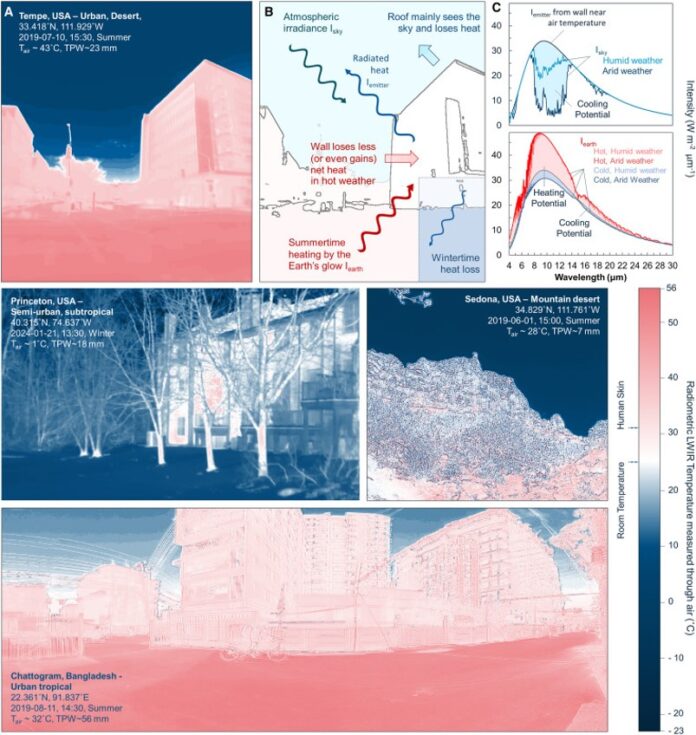Research being done at Princeton University and UCLA has led to a potential passive material for heating and cooling the interiors of buildings. A June 27, 2024 press release highlights the results which appeared in the open-access journal Cell Reports: Physical Science, entitled, “Radiative cooling and thermoregulation in the earth’s glow.” (A quick aside related to published research articles. I read many titles that don’t tell the story. This is one of them. How would I describe this research in a title? Here is my take: “The Discovery of thermo-regulating commonly found materials for walls and windows in buildings and homes.” I would add a subtitle, “An adaptation strategy for combatting global warming.”
Jyotirmoy Mandal, assistant professor of civil and environmental engineering at Princeton, has described what the researchers learned in a Princeton press release. He notes that by tailoring the optical properties of building or home envelopes (its walls, windows and doors) through the application of an extra layer of commonly available materials, you could dramatically reduce HVAC heating and cooling energy usage and need.
The practical science behind this is as follows. Heat moves from built structures into the surrounding atmosphere as narrowband infrared radiation. The heat coming from the ground ranges across the entire infrared spectrum and is called broadband. Professor Mandal notes: “By coating walls and windows with materials that only radiate or absorb heat in the atmospheric window, we can reduce broadband heat gain from the ground in the summer, and loss in the winter while maintaining the cooling effect of the sky. We believe that this idea is unprecedented and beyond what traditional roof and wall envelopes can achieve.”
The research team sought suitable materials that exhibited long-wavelength-infrared (LWIR) characteristics for both radiative cooling and heating noting that most research to date didn’t address vertical surfaces. Sky-facing solutions have employed the painting of roofs white, or using applications of porous polymers, silver-backed multilayer films or polymer composites to reverse the effects of LWIR.
Vertical walls and windows which in sum represent a much greater surface area than roofs were largely neglected. The Princeton and UCLA teams used power flow experiments and simulations of relative heating and cooling characteristics using different materials applied to roofs, walls, and windows. They tested metallized polypropene, paint resins, and ceramics whose scalability, costs, and compatibility would make them feasible and affordable building and home solutions.
Their experiments exposed vertically oriented selective and broadband thermal emitters to summer and wintertime environments in Los Angeles and Princeton. Materials chosen included:
- silvered poly (4-methyl-1-pentene) used in packaging and containers.
- silvered poly (vinylidene difluoride) used in solar panel facings.
- alumina which today is used in tiles
- polypropylene sourced from household plastic waste.
Varying application thicknesses when applied demonstrated their LWIR tendencies. The results showed that common-use materials when applied to thermoregulate buildings could be an immediate solution for combatting the rising number of heat domes that large areas of the planet have been experiencing as mean global atmospheric temperatures rise.
The “untapped energy savings,” Mandal notes could serve buildings in the Global South and resource-poor communities in the Global North. The materials are readily available and sourcing and application can be done quickly. He describes the outcome of this research as an “equitable solution” to meet “increasing cooling demands” while reducing “heat-related mortalities.”
Today, seasonal heat-related deaths are on the rise. As mean atmospheric temperatures exceed a 1.5 Celsius (2.7 Fahrenheit) rise, heat mortality numbers are climbing. What the Princeton-UCLA research points to is a way for humanity to adapt buildings and homes to deal with higher temperatures. So if you are reading this, please spread the word about what this research is showing, a potential game-changer and workable adaptation strategy for combatting atmospheric warming. It shouldn’t be expensive to implement and considering how much plastic pollution can be harvested from the environment, much of the materials needed will be readily available.









